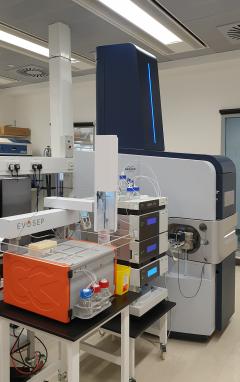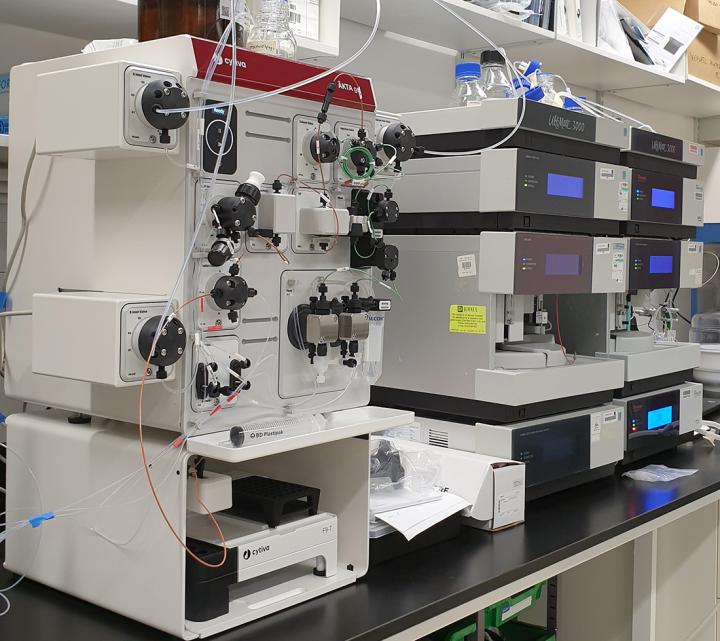Instrumentation
A range of analytical instrumentation with complimentary features are available for studying proteins and small molecules.

High Resolution Mass Spectrometers
The facility is equipped with an ultrasensitive, high resolution, Ion-mobility enabled LC-MS instrument (timsTOF fleX), as well as a Q-ToF and an IonTrap mass spectrometers offering ElectroSpray Ionisation (ESI) capabilities and are interfaced with nano and analytical UHPLC systems.
Based on either Collision-Induced Dissociation (CID) or Electron Transfer Dissociation (ETD) fragmentation approaches, these LC-MS systems allow identification and quantification of proteins, peptides and metabolites in samples using a variety of established methods.

The timsTOF fleX is a dual source instrument with ESI and MALDI capabilities. In ESI mode, when combined with our nanoUHPLC systems, it offers ultra-deep proteome coverage with very small amounts of proteins.
This is a fast scanning instrument (>100 Hz) and boasts novel scan modes PASEF and diaPASEF offering 4D proteomics technology. The ion mobility dimension of this instrument enables increased sensitivity and selectivity of proteins and metabolites, and analysis of post-translational modifications.
Data Independent Acquisition (DIA) strategies and Collision Cross Section (CCS) measurements on this instrument aid in matching between runs, thereby minimising missing value problem to a great extent.
Imaging MS capability
The integrated MALDI source enables fast Mass Spec Imaging (MSI) of tissue sections with very high spatial resolutions, showing the molecular distribution of hundreds of analytes including metabolites, lipids, drugs and peptides.
MSI can reveal regional distributions of analytes or molecular co-distribution in specific compartments on tissues, organoids, 3D cell cultures or biofilms. This provides vital information on the spatial distribution of molecules, which otherwise are lost once homogenised.
Once a region of interest is identified on tissues, MSI-guided microdissection can be performed for deep characterisation of the regions in a SpatialOMx workflow.
High throughput LC system

The facility is equipped with an EvoSep One, a novel LC system embedding pre-formed gradients and disposable trap column, which analyses samples in an extremely robust and high-throughput manner enabling clinical and large scale proteomics. It is possible to process 200 complex samples such as hela cell digests to a depth of above 5,000 protein groups in 24 hours while interfaced to timsTOFfleX.
DART (Direct Analysis in Real Time) MS
The facility offers DART MS (Direct Analysis in Real Time MS) for quick screening and classification of samples. This uses DART SVP Ion source from IonSense Ltd. This emerging technology can analyse a wide variety of samples in-situ and mostly without elaborate sample preparations.
Solid samples can be directly introduced to the mass spec providing instantaneous ionisation of surface analytes, such as metabolites, lipids, glycans, drugs and peptides, enabling chemical profiling and classification of samples of biological origin.
Near instantaneous profiling by DART MS allows monitoring changes in the chemical profiles, even on live organisms, and characterising strain variation or species identification in plants and microbes.
Chromatographic systems
The facility also has multiple chromatographic systems such as AKTAGo, Dionex Ultimate 3000 (analytical), EASYnLC and RSLCnano for protein/peptide purification and fractionation at semi-preparative, analytical and nano scales. These systems enable separation of proteins/peptides and other biomolecules based on size exclusion, ion-exchange, hydrophilic interaction and reverse-phase chromatographic principles.
Data processing software
We have full software suite for proteomics/metabolomics and mass spec imaging workflows including Mascot (Matrix Science) and Progenesis (Waters), PEAKS Xpro (Bioinfor Ltd), paSER (Bruker) MetaboScape (Bruker), TASQ (Bruker), SCiLS Lab Premium (Bruker) and a variety of open-source/freeware tools, such as MaxQuant, FragPipe, DIA-NN and Perseus.


